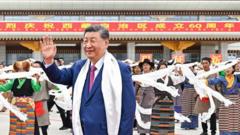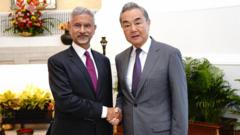In a surprising move, Chinese President Xi Jinping visited Tibet to mark the 60th anniversary of the region's autonomous status, addressing a crowd of 20,000 in Lhasa. This marked only his second visit to the closely monitored area, as he touted unity, stability, and development amidst ongoing tensions with Tibetan separatists.
Xi Jinping's Surprise Tibet Visit Highlights Unity and Development Goals

Xi Jinping's Surprise Tibet Visit Highlights Unity and Development Goals
China's President Xi Jinping makes a rare appearance in Tibet to commemorate its 60th anniversary as an autonomous region, emphasizing unity against separatism.
Xi’s visit came on the heels of the Dalai Lama's announcement that his office would choose his successor—a move that highlights the continuing rift between Tibetan aspirations for autonomy and Beijing's approach. Xi emphasized the importance of maintaining "political stability, social stability, ethnic unity, and religious harmony" in his speech, which notably did not mention the Dalai Lama.
Earlier initiatives by the Chinese government have included laws aimed at assimilating Tibetan culture and language into a broader national framework, with Tibetan children now required to attend state-run schools in Mandarin. Meanwhile, the construction of what is set to be the world's largest dam on the Yarlung Tsangpo river—a project worth roughly $167 billion—has sparked significant concerns surrounding environmental impacts and regional water control tensions with neighboring India and Bangladesh.
Xi’s visit was widely covered in state media, presented as a significant event, complete with traditional Tibetan performances. His conversations with local leadership revolved around enhancing economic and cultural exchanges, aiming for a strategic vision in managing Tibet’s future. Despite official assertions that living standards have improved under Beijing’s rule, human rights advocates continue to express concerns about the erosion of Tibetan identity and freedoms.
This high-profile visit underlines the sensitive dynamics of governance in Tibet and China’s persistent efforts to maintain control over the region's narrative amid international scrutiny.
Earlier initiatives by the Chinese government have included laws aimed at assimilating Tibetan culture and language into a broader national framework, with Tibetan children now required to attend state-run schools in Mandarin. Meanwhile, the construction of what is set to be the world's largest dam on the Yarlung Tsangpo river—a project worth roughly $167 billion—has sparked significant concerns surrounding environmental impacts and regional water control tensions with neighboring India and Bangladesh.
Xi’s visit was widely covered in state media, presented as a significant event, complete with traditional Tibetan performances. His conversations with local leadership revolved around enhancing economic and cultural exchanges, aiming for a strategic vision in managing Tibet’s future. Despite official assertions that living standards have improved under Beijing’s rule, human rights advocates continue to express concerns about the erosion of Tibetan identity and freedoms.
This high-profile visit underlines the sensitive dynamics of governance in Tibet and China’s persistent efforts to maintain control over the region's narrative amid international scrutiny.















